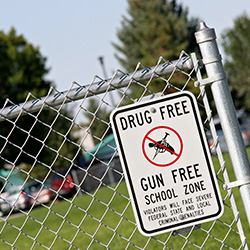 |
School security has increasingly become an area of focus among school boards and municipalities. Officials are constantly seeking to implement or improve security and safety policies, procedures and technologies to offer the highest level of protection for students, staff and visitors. Every second counts in an emergency or crisis, making it imperative that schools have policies and procedures in place that make it possible to lock down buildings instantly while simultaneously providing alerts and critical information to on-site personnel and first responders to determine the most prudent course of action to safely evacuate occupants and apprehend intruders.
At the same time, schools must also implement policies for performing day-to-day security functions, such as limiting access to facilities and identifying potential internal threats. There are a number of best practices that can help schools identify and address a wide variety of potential issues, including an active shooter, medical emergency, missing students or other crisis situations. Below are a few of the most effective best practices schools can follow to improve the safety and security of students, staff and visitors.
Instant lockdown and notification
In any crisis situation, time is of the essence. In some cases, a few seconds can mean the difference between safety and tragedy. Therefore, it’s important to implement policies and systems that instantly trigger lockdown and/or evacuation procedures as appropriate to increase security and maximise the safety of students, teachers and others in the building. Additionally, technologies that provide the ability to generate and send automatic alerts reduces the time to notify appropriate authorities, as well as any delays associated with those calls.
Simple alert notification process
When policies and procedures are overly complicated, at best they can waste valuable time in a crisis situation; at worst, they could be ignored completely. That’s why the alerting process should be as simple as possible while still being effective. Ideally, teachers should be able to generate alerts by the simple press of a button. Mobile capability that enables those alerts to be sent from a laptop, smartphone or tablet further increases safety by allowing teachers to send notifications from anywhere within the building.
Effective two-way communication
Schools must also implement policies for performing day-to-day security functions, such as limiting access to facilities and identifying potential internal threats |
In a crisis, the ability to communicate is critical. Therefore, schools must implement policies that dictate what information needs to be provided and how that information is communicated. Among the potential alerting tools are text message, email, phone, instant messaging or the school’s paging system. Regardless of the chosen medium, all communication must be two-way in order to provide up-to-date information to school officials and first responders. This will enable them to determine the appropriate next steps, whether that be to remain in lockdown mode or to initiate evacuation procedures depending on the specific crisis or situation or to communicate additional instructions to the teachers as the situation is evolving.
Flexible security measures
There is no guarantee that what works to increase safety and security today will also work tomorrow. Because potential threats to safety and security can and do change, it is important that whatever policies, procedures and technology a school implements today can also evolve to address those changes well into the future. It is also important that schools take into account the need to distinguish between a wide variety of possible situations to ensure the appropriate people are notified and correct procedures followed. For example, the response to an active shooter situation is going to be very different from the response to a fight that occurs in a hallway.
Private alerting systems
Some alerting policies and systems rely on teachers placing either a green or red card in the window of their classroom, combined with audible alarms and/or announcements. These procedures can actually do exactly the opposite of what they are intended to do. When a teacher places a card in the classroom window or under the door into the corridor they become visible from the outside and tell an intruder that the room is occupied, exposing themselves and their students to potential danger. Audible announcements tell students and staff to report to a specific location, but in doing so they inform an intruder or active shooter where to find victims. Therefore, schools should seek out procedures and technologies that generate alerts and enable private communication and reporting to keep vital knowledge from intruders.
Real-time situational awareness
School districts everywhere are struggling with tight budgets that don't leave much room for state-of-the-art access control and alerting systems |
A fast response is essential for quickly resolving a crisis and returning the school to a safe environment. However, this need for speed could potentially expose law enforcement and first responders to a dangerous, high-risk situation. With little or no information, including where within the building a crisis may be unfolding or how many people are involved, they are entering the situation blind. Schools must have procedures and/or technology that are capable of providing law enforcement and first responders with fully updated information about the incident. Real-time mobile-enabled status updates that include mapping information allow professionals to arrive at the scene with the vital awareness they need to enter the premises safely and make the best tactical manoeuvres to remove a threat as quickly as possible to protect students and staff.
Cost-effective physical security solutions
School districts everywhere are struggling with tight budgets that don’t leave much room for state-of-the-art access control and alerting systems and technologies. As a result, to fit these critical purchases into available funding, officials often “settle” for the solutions they can afford, even if they offer only limited functionality. The good news is that there are more robust, cost-effective solutions available that provide schools with the high level of security they need without busting budgets. Solutions that can be easily implemented using existing networks and infrastructure and/or offer the ability to integrate with other systems – mass notification and door locking systems, for example – further increase the cost-effectiveness and value these systems offer.
The importance of protecting students, staff and visitors has made this critical function a main focus of school boards and municipalities everywhere. By following these top best practices, schools can ensure they are implementing the most effective mix of policies, procedures and technologies that enable the speed, communication and awareness that will increase the safety and security of students, staff and visitors – and potentially prevent a situation from becoming the kind of tragedy that makes national headlines.





















